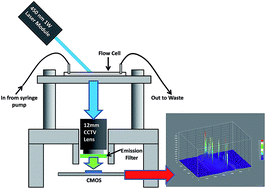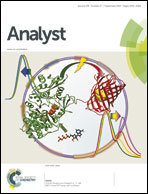Webcam-based flow cytometer using wide-field imaging for low cell number detection at high throughput
Abstract
Here we describe a novel low-cost flow cytometer based on a webcam capable of low cell number detection in a large volume which may overcome the limitations of current flow cytometry. Several key elements have been combined to yield both high throughput and high sensitivity. The first element is a commercially available webcam capable of 187 frames per second video capture at a resolution of 320 × 240 pixels. The second element in this design is a 1 W 450 nm laser module for area-excitation, which combined with the webcam allows for rapid interrogation of a flow field. The final element is a 2D flow-cell which overcomes the flow limitation of hydrodynamic focusing and allows for higher sample throughput in a wider flow field. This cell allows for the linear velocity of target cells to be lower than in a conventional “1D” hydrodynamic focusing flow-cells typically used in cytometry at similar volumetric flow rates. It also allows cells to be imaged at the full frame rate of the webcam. Using this webcam-based flow cytometer with wide-field imaging, it was confirmed that the detection of fluorescently tagged 5 μm polystyrene beads in “1D” hydrodynamic focusing flow-cells was not practical for low cell number detection due to streaking from the motion of the beads, which did not occur with the 2D flow-cell design. The sensitivity and throughput of this webcam-based flow cytometer was then investigated using THP-1 human monocytes stained with SYTO-9 florescent dye in the 2D flow-cell. The flow cytometer was found to be capable of detecting fluorescently tagged cells at concentrations as low as 1 cell per mL at flow rates of 500 μL min−1 in buffer and in blood. The effectiveness of detection was concentration dependent: at 100 cells per mL 84% of the cells were detected compared to microscopy, 10 cells per mL 79% detected and 1 cell per mL 59% of the cells were detected. With the blood samples spiked to 100 cells per mL, the average concentration for all samples was 91.4 cells per mL, with a 95% confidence interval of 86–97 cells per mL. These low cell concentrations and the large volume capabilities of the system may overcome the limitations of current cytometry, and are applicable to rare cell (such as circulating tumor cell) detection The simplicity and low cost of this device suggests that it may have a potential use in developing point-of-care clinical flow cytometry for resource-poor settings associated with global health.


 Please wait while we load your content...
Please wait while we load your content...